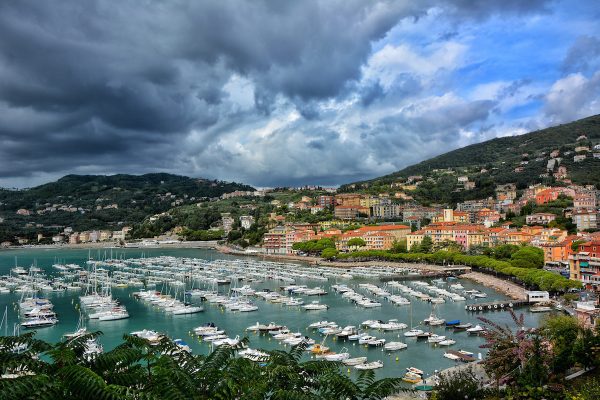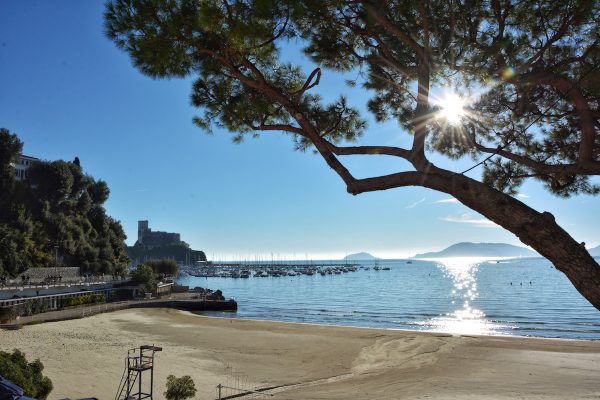Lerici

Lerici
Lerici is a Ligurian town of approximately 10,200 inhabitants in the province of La Spezia, located along the Riviera di Levante. It is one of the most famous seaside towns in Liguria and overlooks the Golfo dei Poeti (Gulf of La Spezia). The Gulf carries the name of Gulf of Poets because over the years it has hosted many well-known artists from both Italy and abroad, including poets, writers, and actors.

Lerici
Territory
Lerici is located at the eastern tip of the Gulf of La Spezia, at the centre of a small, evocative natural cove overlooked by a promontory on which is built the famous Castle of Lerici. The town is part of an area of natural, historical, and cultural interest known as Parco Montemarcello-Magra-Vara. The dominant vegetation is Mediterranean scrub, alternating with holm oak woods and garrigue, as well as large olive groves. Its temperate climate makes it a well-appreciated tourist attraction in every season.
History
This city’s history is ancient: the first settlement goes back to the Etruscan period (VII century B.C.). Afterwards, its privileged geographical position made it an important natural post used firstly by the Ligurians and then the Romans. During the Middle Ages, its importance grew both commercially and religiously (it became one of the most used ports by pilgrims en route to the main Christian destinations of that time), and in 1152 it became the property of the Republic of Genoa. In 1241 it passed under the dominion of the Republic of Pisa: it was in this period that the town was fortified and the Castle built. Pisa’s dominance, however, was brief, and Lerici returned under the control of Genoa, who completed the Castle and continued to fortify the city. From the end of the 1300s to the second half of the 1400s it fell under a series of dominions (including French, Florentine, and Aragonese), until it definitively returned to Genoese territory (1479). In 1815 it was annexed to the Kingdom of Sardinia and then the Kingdom of Italy (1861).
What to Visit in Lerici
Lerici is an important swimming and holiday destination which offers, in addition to excellent accommodation and restaurants (based on a network of hotels, bed & breakfasts, restaurants, cafes, etc.), an ideal location for active tourism.
Within the old city, where the characteristic Ligurian layout reflects its Medieval structure, there are a number of culturally interesting locations. The most important is certainly the Castello Monumentale di Lerici, which dominates the city perched on a rocky promontory. The building, considered to be an excellent example of military architecture, is among one of the most beautiful in Liguria. Inside is a thirteenth-century chapel built in a Gothic-Ligurian style dedicated to Santa Anastasia, and a geo-paleontological museum, with a large collection and exhibition of minerals and fossils. Other structures that are a part of the city’s cultural heritage and deserve a visit are:
- The tower of San Rocco, built during the Roman period as a lookout tower then transformed into a bell tower in the XVI century;
- The local church of San Francesco D’Assisi, built at the end of the 1200s;
- The fifteenth-century oratory of San Bernardino, currently closed for worship;
- Ca’ Doria, the home of the famous Genoese admiral, Andrea Doria;
- Villa Padula, home of the English baroness and writer Emuska Orczy Borstow (author of the well-known novel, “The Scarlet Pimpernel”).

Lerici Beach
Lerici also has particularly beautiful natural locations: on the one hand are the beautiful landscapes in the inland hills, on the other the splendid beaches along the coast, well-known and with their shallow water and sandy beaches. Among these are:
- Lido di Lerici, a beach resort with a gently sloping beach and a large tract of shallow water;
- San Giorgio beach, a public beach located in a bay of exceptional beauty and which can be accessed through the tunnel under the Castle;
- Ciccillo a Mare, a property on the rocks at the foot of the Castle, home to a bar and restaurant and a charming terrace overlooking the sea;
- Venere Azzurra, a public beach on the area between Lerici and San Terenzo awarded since 2000 with the Blue flag from the FEE and 4 sails from Legambiente for its water quality and services;
- Baia Blu, an incredible cove nestled between Punta Santa Teresa and Punta Galera home to a public and a private beach with a number of services, including a restaurant, three cafes, and two pools;
- Caletta, a small inlet between Lerici and Tellaro where the wreckage of a Roman ship from the I century A.D. can be found on the sea floor. This location is part of a scuba diving itinerary of great archaeological and natural interest (thanks tot he presence of a number of rare varieties of marine flora and fauna).
Boating in Lerici
The port of Lerici is located in the area under the Castello and is made up of a long pier of approximately 250m, two jetties, and a berth. There are a number of city-managed catenaries for anchoring pleasure boats. The available spaces are 1300, of which 8 are reserved for transit. Only boats shorter than 15 metres long are allowed to anchor and it is forbidden to drop anchor in areas intended for fishing boats and open transit.
Services offered:
- Fuel distribution (petrol, diesel, blended fuel);
- Drinking water fountains;
- Berth illumination;
- Two cranes, one 15t mobile and one 3.5t fixed;
- Repair services (engines, electric and electronics, hull);
- Divers;
- Toilet and shower facilities.
Topics: Golfo dei Poeti, Gulf of Poets, Lerici, Parco Regionale di MonteMarcello, riviera di levante, Western Riviera



